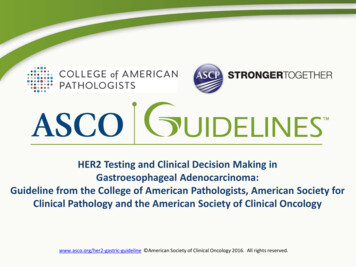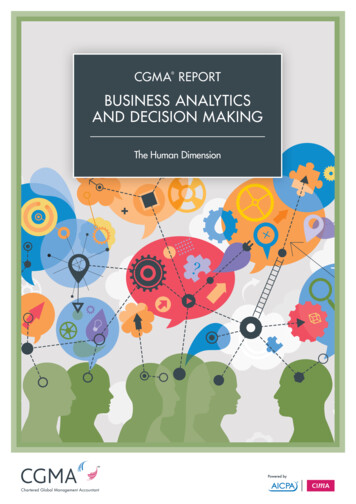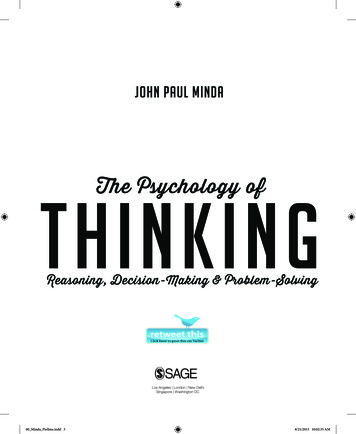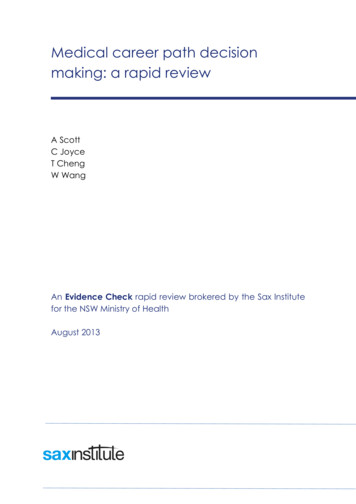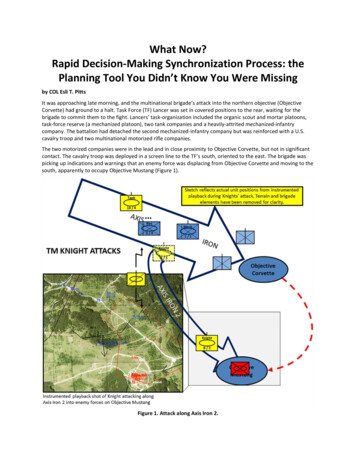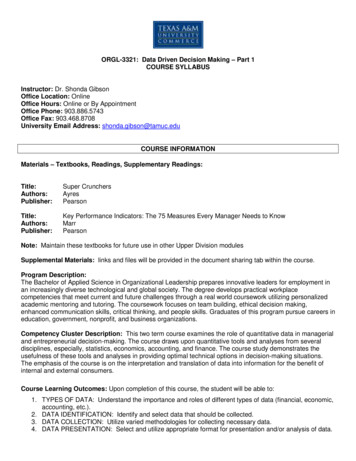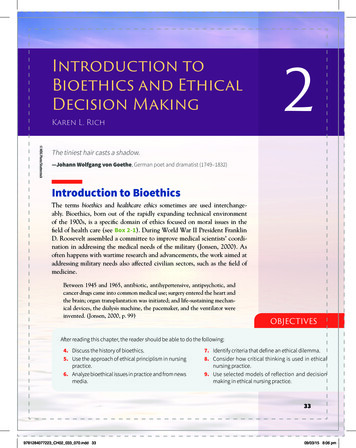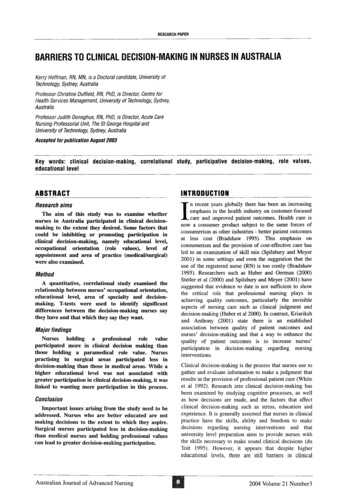
Transcription
RESEARCH PAPERBARRIERS TO CLINICAL DECISION-MAKING IN NURSES IN AUSTRALIAKerry Hoffman, RN, MN, is a Doctoral candidate, University ofTechnology, Sydney, AustraliaProfessor Christine Duffield, RN, PhD, is Director, Centre forHealth Services Management, University of Technology, Sydney,AustraliaProfessor Judith Donoghue, RN, PhD, is Director, Acute CareNursing Professorial Unit, The St George Hospital andUniversity of Technology, Sydney, AustraliaAccepted for pUblication August 2003Key words: clinicaleducational leveldecision-making,correlationalstudy, participative decision-making,role values,ABSTRACTINTRODUCTIONResearch aimsnrecent years globally there has been an increasingemphasis in the health industry on customer-focusedcare and improved patient outcomes. Health care isnow a consumer product subject to the same forces ofconsumerism as other industries - better patient outcomesat less cost (Bradshaw 1995). This emphasis onconsumerism and the provision of cost-effective care hasled to an examination of skill mix (Spilsbury and Meyer2001) in some settings and even the suggestion that theuse of the registered nurse (RN) is too costly (Bradshaw1995). Researchers such as Huber and Oerman (2000)Stetler et al (2000) and Spilsbury and Meyer (2001) havesuggested that evidence to date is not sufficient to showthe critical role that professional nursing plays inachieving quality outcomes, particularly the invisibleaspects of nursing care such as clinical judgment anddecision-making (Huber et al 2000). In contrast, Kriarikshand Anthony (2001) state there is an establishedassociation between quality of patient outcomes andnurses' decision-making and that a way to enhance thequality of patient outcomes is to increase nurses'participation in decision-making regarding nursinginterventions.The aim of this study was to examine whethernurses in Australia participated in clinical decisionmaking to the extent they desired. Some factors thatcould be inhibiting or promoting participation inclinical decision-making, namely educational level,occupational orientation (role values), level ofappointment and area of practice (medical/surgical)were also examined.MethodA quantitative, correlational study examined therelationship between nurses' occupational orientation,educational level, area of specialty and decisionmaking. T-tests were used to identify significantdifferences between the decision-making nurses saythey have and that which they say they want.Major findingsNursesholdinga professionalrole valueparticipated more in clinical decision making thanthose holding a paramedical role value. Nursespractising in surgical areas participated less indecision-making than those in medical areas. While ahigher educational level was not associated withgreater participation in clinical decision-making, it waslinked to wanting more participation in this process.ConclusionImportant issues arising from the study need to beaddressed. Nurses who are better educated are notmaking decisions to the extent to which they aspire.Surgical nurses participated less in decision-makingthan medical nurses and holding professional valuescan lead to greater decision-making participation.Australian Journal of Advanced NursingIClinical decision-making is the process that nurses use togather and evaluate information to make a judgment thatresults in the provision of professional patient care (Whiteet al 1992). Research into clinical decision-making hasbeen examined by studying cognitive processes, as wellas how decisions are made, and the factors that affectclinical decision-making such as stress, education andexperience. It is generally assumed that nurses in clinicalpractice have the skills, ability and freedom to makedecisions regarding nursing interventions and thatuniversity level preparation aims to provide nurses withthe skills necessary to make sound clinical decisions (duToit 1995). However, it appears that despite highereducational levels, there are still barriers in clinical2004 Volume 21 Numbed
RESEARCH PAPERpractice that prevent nurses participating in decisionmaking to the extent they want. If, as reported, effectivenurse decision-making improves patient outcomes, it isnecessary to begin to understand the barriers that preventnurses participating fully in this critical aspect of theirpractice.LITERATUREREVIEWThe processes that nurses use in clinical decisionmaking have been investigated using different methods.To date researchers have examined the cognitiveprocesses' involved in decision-making using think aloudprotocols (TAP) (Grobe et al 1991; Aitken 2000; Aitkenand Mardegan 2000), decision analysis (Panniers andWalker 1994) and content analysis (Tschikota 1993).Nurses are believed to use a hypothetico-deductivecognitive model in decision-making, where nurses gatherinformation, make a hypothesis and then gather cues toeliminate or support the hypothesis (Westfall et al 1981;Thompson 1999; Taylor 2000). Decision-making has alsobeen studied using participantobservation andinterviewing. Intuitive processes have been described byBenner and Tanner (1987) as a process of decisionmaking used by nurses. Intuition is believed to be aknowing without rationale and is believed to developthrough experience (Benner and Tanner 1987; Dreyfus1992; Benner et al 1999; Buckingham and Adams 2000).Nurses' values and beliefs about whether they shouldmake decisionsinfluencetheir decision-makingbehaviour (Augoustinos and Walker 1995). Valuescontain both an affective and cognitive dimension andserve as criteria for decision-making (Berggren et al2002). A role is a person's pattern of behaviour thatresults from the constructs that a person holds (Feist1994) to a specific position in society (Augoustinos andWalker 1995). In nursing, the values and beliefs held bynurses towards their work and occupation constitute theiroccupational ideology. These beliefs and values areshaped by societal and institutional norms andinternalised by nurses (Lauri and Salantera 1995). Thework values held by individual nurses will have beenshaped by socialisation processes within and external tonursing (du Toit 1995; Yung 1996) and internalised toform nurses' values to work. An example of socialisedrole development is seen where nurses take a passive rolewhen working with medical staff leading to a lack ofindependent judgements by nurses (Oughtibridge 1998).Rhodes (1985) outlined three role values that nurseshold and related these to participation in decision-making.Those who hold 'paramedical' role values and seethemselves as physicians' helpers act subserviently andoften do not make independent decisions regardingeveryday nursing care (Rhodes 1985). Those who hold'bureaucratic' values believe that the hospital organisationshould make decisions for them and also do not oftenmake independent decisions (Rhodes 1985). On the otherhand, those nurses who hold 'professional' values and aAustralian Journal of Advanced Nursingbelief in autonomous decision-making are willing toparticipate in clinical decision-making (Rhodes 1985).Nurses worldwide are reporting that they want to beable to participate in decision-making more than theycurrently do. In Israel, Misener et al (1996) found nurseswanted more decision-making authority, responsibilityand control and that there was a discrepancy between thedecision-making in which nurses actually participated andthose in which they wanted to participate. This findingwas attributed to the authoritarian management stylecommon in Israel. Wulff (1991) also found differences inthe amount of decision-making in which nursesparticipated in the United States of America (USA) andwhat they wanted to participate in, stating that they wantto be able to participate more.The participation in decision-making in this study wasmainly correlated to personal characteristics. However,Wulff (1991) also found that some job attributes, such asnurse leadership style, affected participation in decisionmaking. A study which examined the type of decisionsnurses can make and what kind they want to make, foundthat nurses frequently did not independentlyorconsistently make patient care decisions in those areasidentified as belonging to the nursing domain such as rest,nutrition, elimination and mobility (Prescott et al 1987).These authors concluded that nurses' characteristics suchas education, experience, and interpersonal styles affectclinical decision-making. The magnet hospital research,also in the USA, has demonstrated links between nursedecision authority and greater retention and jobsatisfaction, with nurses choosing to work in areas withgreater decision authority (Scott et al 1999; Curley 2002;Ritter-Teitel 2002). In Australia, O'Connell and Warlow(2001) state that nurses often feel they are in situationswhere they are unable to change aspects of patient careand that nurses lack autonomy within hospital systems.However, these researchers did not examine whethernurses want more decision authority.Nurses are being educated at the tertiary level to useskills such as problem solving, critical thinking andreflection to develop good clinical decision-makingabilities. However, despite nurses being equipped with thenecessary skills to make decisions regarding patient care,they still feel their participation in clinical decisionmaking is being constrained (Misener et al 1996). InAustralia, du Toit (1995) found that student nurses at auniversity were being socialised into professional roleswith independent decision-making being an importantaspect of that role, which led to a high willingness tomake clinical decisions. Several authors echo thissentiment that students are socialised into roles atuniversity and also learn roles in the workplace (Yung1996; Beecroft 1999; Wade 1999; Cullen 2000). Oneimportant aspect of the professional role of nurses is thebelief in autonomous nursing practice that can beexpressed as greater participation in clinical decision, making. University educated nurses also appear to besocialised to value autonomy and in tum, expect a high2004 Volume 21 Number 3
RESEARCH PAPERlevel of involvement in clinical decision-making (du Toit1995).The amount of autonomy that nurses have varies fromhospital to hospital and unit to unit, as does the extent towhich nurses can make decisions (Prescott et al 1987).Clinical autonomy is a role characteristic that is sociallyconstituted and so a nurse's position in a ward may act toconstrain their clinical autonomy and decision-making(Cash 2001). Much variability exists in both the decisionsnurses can make and the extent to which nurses want tomake decisions, and there may be barriers to nurses'clinical decision-making as a result of the type of hospitalor ward in which they work. Nurses working in areas suchas community health, critical care and mental health aremore independent decision-makers (Bucknall andThomas 1996). In England differences in participation indecision-making were found between nurses on medicaland surgical wards, with medical wards having less needfor frequent medical intervention and greater need forskilled nursing care, leading to greater self-confidenceand autonomy in practice for medical nurses (Adams et al1997). The differences in nursing autonomy betweenmedical and surgical wards were due to the nurses on themedical wards needing to implement skilled nursinginterventions more frequently (Adams et al 1997).Surgical nurses had less uncertainty to tolerate and hadfewer chances to develop self-confidence and autonomyin their practice (Adams et al 1997). There has been littleresearchin Australia concerning similarities ordifferences in medical/surgical wards.A nurse's level of appointment has also been shown toaffect participation in clinical decision-making. Bucknalland Thomas (1996) examined both the frequency withwhich nurses reported they made decisions and therelationship between level of appointment and decisionsmade. They concluded that nurses practising at a higherlevel made more decisions than those practising at a lowerlevel, which supports the work of Schutzenhofer et al(1996). Lower levels of appointment may act as a barrierto participation in clinical decision-making. This might bequite appropriate in some cases.METHODIn this study decision-making was defined as thosedecisions made by nurses in their usual clinical practiceand incorporated aspects such as activities of daily living,wound dressings, medication administration, emotionalsupport and referrals to other services. The frequencywith which nurses make such decisions was assessed andcorrelated to a number of factors. The study used acorrelational design to examine the relationships betweenselected factors and decision-making by nurses inAustralia.InstrumentsTwo questionnaires, one that identified role values(occupational orientation) and one that assessed decision-Australian Journal of Advanced Nursingmaking were used after Rhodes (1985) grantedpermission. A pilot study was conducted to determine thesuitability of the questionnaires for Australian conditionsfollowing which the wording of the questionnaires weremodified slightly. The occupational orientation (rolevalues) questionnaire consisted of 26 items making upthree sub-scales that tested:i) professional role values: for example 'Nursingduties should be defmed by the nursing profession'eight items;ii) paramedical role values: for example 'Nursingduties should be defined by the medical profession'nine items; and,iii) bureaucratic role values: for example' The areamanagement should decide what work nurses shoulddo.' nine items (Rhodes 1985).Each item of the scale had a five-point Likert scaleranging from strongly agree (5) to strongly disagree (1).The decision-making questionnaire consisted of twosubscales, one for perceived decision-making and one fornormative decision-making. This inventory consists of 23items for the perceived subscale and 23 items for thenormative subscale. Each item on the decision inventoryh
skills such as problem solving, critical thinking and reflection to develop good clinical decision-making abilities. However,despite nurses being equipped with the necessary skills to make decisions regarding patient care, they still feel their participation in clinical decision-making is being constrained (Misener et al 1996). In Australia, du Toit (1995) found that student nurses at a .

